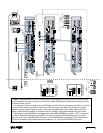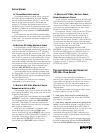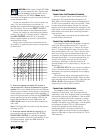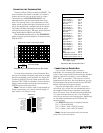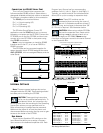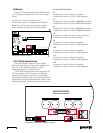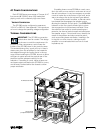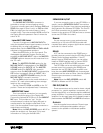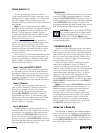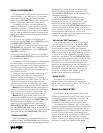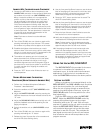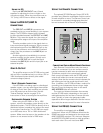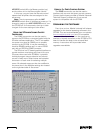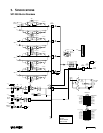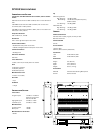
SP1200 – 17
PAGING MIC CONTROL
The
PAGING MIC CONTROL
connector is
provided to connect a manual paging switch.
Connect a normally-open switch between
GND
and
ZONE A
(to page in Zone A only), or
GND
and
ALL
CALL
(to page over the entire system--if using
multiple units). The voice-activated (
VOX
) control for
the Paging Mic still operates in Zone A when the
switch is off.
Local MIC/LINE Input
Connect a microphone to
MIC/LINE INPUT A
,
using the supplied Phoenix-type connector, to use for
a meeting room or other local speaking
requirements. Set the
PHANTOM
and
GAIN +40 dB
switches to their appropriate positions.
Select the
OFF
button on the front panel. This
disengages the selected Program Source and
engages the
MIC/LINE INPUT
. Adjust the
MASTER
VOLUME
up/down buttons so the meter level is at
the “0” mark.
Note: The
MASTER VOLUME
setting for the
MIC/LINE INPUT
is independent of the
MASTER
VOLUME
setting for
INPUTS 1-4
. The
MASTER
VOLUME
setting for
INPUTS 1-4
is stored in
memory when the
MIC/LINE INPUT
is selected (the
OFF button is engaged). When an
INPUT 1-4
is
selected, the
MASTER VOLUME
setting for the
MIC/LINE INPUT
is stored in memory.
Set the
GAIN
control so the meter indication is
near the “
0
” mark when speaking at an average
level into the microphone.
Set the 2-band EQ (
LOW
and
HIGH
) to the “
U
“
position. These can be adjusted later, if necessary.
AMBIENT MIC Input
This is an optional connection, but can greatly
enhance the performance of the Paging Mic.
Connect the optional MT-3100 mic to the
AMBIENT
MIC
input. This provides an “ear” for the
microprocessor to adjust the Paging Mic gain to
compensate for the ambient noise level in the
room. Use the supplied Phoenix-type connector to
make these connections.
Note: Move the
AMP ADDRESS
switch #8 UP to
enable the ambient mic. See page 19 for more
information on "Using the Ambient Mic."
EXPANSION IN/OUT
If you are connecting two or more SP1200s in a
system, use the
EXPANSION IN/OUT
connections
to distribute the Program Input sources assigned to
the Expansion Bus between SP1200s. The two 25-
pin D-Sub connectors are in parallel (use one to
connect to the previous SP1200 and one to connect
to the next SP1200 in the chain).
Remote
You can connect one or more optional remote
controls (up to 10) to the SP1200 to provide wall-
mounted input select, program signal volume control,
and local mic volume control.
RS485
A PC can be connected to the RS485 port to
provide computer control using the SPLinker Sound
Palette Control software application. If the PC
doesn't have an RS485 serial port, you can either
install an RS485 interface card, or use an RS232
serial port with an RS232-to-RS485 converter.
Two SP1200s can be controlled with one wired
remote control by connecting the RS485 ports
between the two SP1200s. Each amplifier must
have the same
AMP ADDRESS
with one assigned
as Master and the other as Slave. Use the supplied
Phoenix-type connectors to make these
connections.
Note: Move the
AMP ADDRESS
switch #6
DOWN for Master and UP for Slave.
PRE OUT/AMP IN
These connections can be used to insert a signal
processor (i.e., graphic equalizer, compressor, etc.)
into the signal chain, or to feed the signal to additional
power amplifiers. If no external processor or external
amplifier is to be used, leave the U-shaped jumper in
place between the
PRE OUT
and
AMP IN
connectors.
Outputs
Use the supplied two-conductor Phoenix-type
connector with appropriate speaker wiring to
connect to the speaker or distributed speaker
system.



